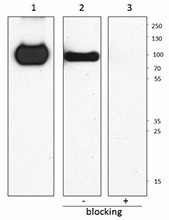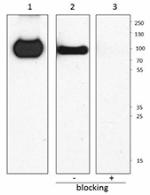- Clone
- M6005H11 (See other available formats)
- Regulatory Status
- RUO
- Other Names
- ACLSD
- Isotype
- Mouse IgG2a, κ
- Ave. Rating
- Submit a Review
- Product Citations
- publications

-

Recombinant human hIGFALS protein (50ng, Lane 1) and human plasma (0.5 µl, Lane 2 and 3) were resolved by electrophoresis, transferred to nitrocellulose, and probed with 1 µg/mL purified monoclonal anti-IGFALS (clone M6005H11) antibody. In lane 3, 3 µg/ml of recombinant human IGFALS was used to compete the Antibody-antigen interaction. The protein was visualized using a goat anti-mouse-IgG secondary antibody conjugated to HRP and chemiluminescence detection.
| Cat # | Size | Price | Quantity Check Availability | Save | ||
|---|---|---|---|---|---|---|
| 680502 | 100 µg | 231€ | ||||
Insulin-like growth factor-binding protein complex acid labile subunit (ALS) is an 85 kD glycoprotein that is produced almost exclusively by the liver and secreted into circulation. The protein surface contains charged residues, which together with the negatively charged N-linked glycosylation on the ALS protein, provides the necessary electrostatic potential to interact with the IGF-I-IGFBP-3 binary complex. The well-established function of ALS is to prolong the half-lives of the IGF-IGFBP-3/IGFBP-5 binary complexes.
In rodents, genetic targeted ablation of the IGFALS gene appeared to increase sensitivity to insulin. In humans, mutations in IGFALS caused ALS deficiency, an autosomal recessive condition featured by a marked reduction in circulating levels of both IGF-I and IGFBP-3. Subjects with ALS deficiency are short and, usually accompanied by compensatory elevated levels of GH. In rare cases, pubertal delay, insulin resistance, and immunological dysfunction were also found.
Product Details
- Verified Reactivity
- Human
- Antibody Type
- Monoclonal
- Host Species
- Mouse
- Immunogen
- Recombinant human IGFALS
- Formulation
- Phosphate-buffered solution, pH 7.2, containing 0.09% sodium azide.
- Preparation
- The antibody was purified by affinity chromatography.
- Concentration
- 0.5 mg/mL
- Storage & Handling
- The antibody solution should be stored undiluted between 2°C and 8°C.
- Application
-
WB - Quality tested
- Recommended Usage
-
Each lot of this antibody is quality control tested by Western blotting. For Western blotting, the suggested use of this reagent is 0.5 - 2.5 µg per ml. It is recommended that the reagent be titrated for optimal performance for each application.
- RRID
-
AB_2566383 (BioLegend Cat. No. 680502)
Antigen Details
- Structure
- 605 amino acids with a predicted molecular weight of 66 kD.
- Distribution
-
Secreted protein.
- Function
- Serum protein bound to IGF to stabilize and assist its vascular localization and is involved in regulating homeostasis and actions of IGFs.
- Interaction
- IGF-I or IGF-II and IGFBP-3.
- Biology Area
- Cell Biology, Signal Transduction
- Antigen References
-
1. Hogler W, et al. 2014. J. Clin. Endocrinol. Metab. 99:E703.
2. Domene HM, et al. 2007. J Clin. Endocrinol. Metab. 92:4444.
3. Domene HM, et al. 2009. Horm Res. 3:129.
4. Janosi JB, et al. 1999. J. Biol. Chem. 74:5992.
5. Janosi JB, et al. 1999. J. Biol. Chem. 274: 23328.
6. Boisclair YR, et al. 2001. J. Endocrinol. 170:63.
7. Haluzik M, et al. 2003. Diabetes. 52:2483.
8. Schreiner F, et al. 2013. Horm. Res. Poediatr. 80:24. - Gene ID
- 3483 View all products for this Gene ID
- UniProt
- View information about IGFALS on UniProt.org
Related Pages & Pathways
Pages
Other Formats
View All IGFALS (ALS) Reagents Request Custom Conjugation| Description | Clone | Applications |
|---|---|---|
| Purified anti-IGFALS (ALS) | M6005H11 | WB |
Compare Data Across All Formats
This data display is provided for general comparisons between formats.
Your actual data may vary due to variations in samples, target cells, instruments and their settings, staining conditions, and other factors.
If you need assistance with selecting the best format contact our expert technical support team.
-
Purified anti-IGFALS (ALS)

Recombinant human hIGFALS protein (50ng, Lane 1) and human p...
 Login / Register
Login / Register 







Follow Us